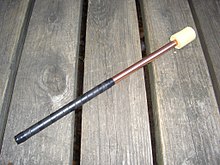Torch: Difference between revisions
Nick Levine (talk | contribs) m Undid revision 316642565 by Nick Levine (talk) what is going on here? sorry .... |
No edit summary |
||
| Line 10: | Line 10: | ||
If a torch is made of [[sulfur]] mixed with [[lime (mineral)|lime]], the fire will not diminish after being plunged into water. Such torches were used by the [[List of topics related to ancient Rome|ancient Romans]]. |
If a torch is made of [[sulfur]] mixed with [[lime (mineral)|lime]], the fire will not diminish after being plunged into water. Such torches were used by the [[List of topics related to ancient Rome|ancient Romans]]. |
||
[http://www.fireworks.co.uk/buy/sparklers_wax-torches_glow.html Procession torches] are made from coarse hessian rolled into a tube and soaked in wax. There is usually a wooden handle and a cardboard collar to deflect any wax droplets. They are an easy, safe and relatively cheap way to hold a flame aloft in a parade, or to provide illumination in any after-dark celebration. |
[http://www.fireworks.co.uk/buy/sparklers_wax-torches_glow.html Procession torches] are made from coarse [[Hessian_(cloth)|hessian]] rolled into a tube and soaked in wax. There is usually a wooden handle and a cardboard collar to deflect any wax droplets. They are an easy, safe and relatively cheap way to hold a flame aloft in a parade, or to provide illumination in any after-dark celebration. |
||
[[Image:Firebreathingtorch.JPG|thumb|right|An unlit torch as used for [[fire breathing]].]] |
[[Image:Firebreathingtorch.JPG|thumb|right|An unlit torch as used for [[fire breathing]].]] |
||
Revision as of 17:40, 1 October 2009

Originally, a torch was a portable source of fire used as a source of light, usually a rod-shaped piece of wood with a rag soaked in pitch and/or some other flammable material wrapped around one end. Torches were often supported in sconces by brackets high up on walls, to throw light over corridors in stone structures such as castles or crypts.
A torch carried in relay by cross-country runners is used to light the Olympic flame which burns without interruption until the end of the Games. These torches and relay tradition were introduced in 1936 Summer Olympics by Carl Diem, chairman of the event because during the duration of the Ancient Olympic Games in Olympia, a sacred flame burns inside of the temple of Hera, kept in custody by her priestess.
If a torch is made of sulfur mixed with lime, the fire will not diminish after being plunged into water. Such torches were used by the ancient Romans.
Procession torches are made from coarse hessian rolled into a tube and soaked in wax. There is usually a wooden handle and a cardboard collar to deflect any wax droplets. They are an easy, safe and relatively cheap way to hold a flame aloft in a parade, or to provide illumination in any after-dark celebration.

Juggling torches are often used as a prop in toss juggling: they can be flipped into the air in an end-over-end motion while being juggled, in the same manner as juggling clubs or juggling knives, but because of their sound and 'trail of flame', they can appear much more impressive to audiences. To a skilled juggler, there is only a slight chance of being burned, but they are still dangerous.
Symbolism

The torch is a common emblem of both enlightenment and hope. Thus the Statue of Liberty, actually "Liberty Enlightening the World", lifts her torch. Crossed reversed torches were signs of mourning that appear on Greek and Roman funerary monuments--a torch pointed downwards symbolizes death, while a torch held up symbolizes life, truth and the regenerative power of flame. The torch is also a symbol used by political parties such as the British Conservative Party (who exchanged it for an oak tree in 2006) and the Malta Labour Party.
In Roman Catholic liturgy

In former times, liturgical torches were carried in Eucharistic processions simply to give light. The Church eventually adopted their use for Solemn High Masses.
According to Adrian Fortescue ("The Mass: A Study of the Roman Liturgy [1912]"), the more correct form of liturgical torches are non-freestanding (i.e. cannot stand up on their own). However, today, even in the Vatican, freestanding, tall candles in ornate candle-stick holders have replaced the former type. The torches are carried by torchbearers, who enter at the Sanctus and leave after Communion.
Anglicans of the High Church and some Lutherans use torches in some of their liturgical celebrations as well.
Blowtorches and similar
In construction usage, a torch is a small hand-held gas burner which makes a hot flame, usually fueled by oxygen and either acetylene or propane, that is used for either cutting or welding metals, particularly iron and steel. Examples include blowtorches, cutting torches, and welding torches. (For more information, see gas welding.)
See also
External links
- Picture of non-freestanding torches Antique Liturgical Torches in Procession
- Picture of non-freestanding torches Antique Liturgical Torches in Procession
